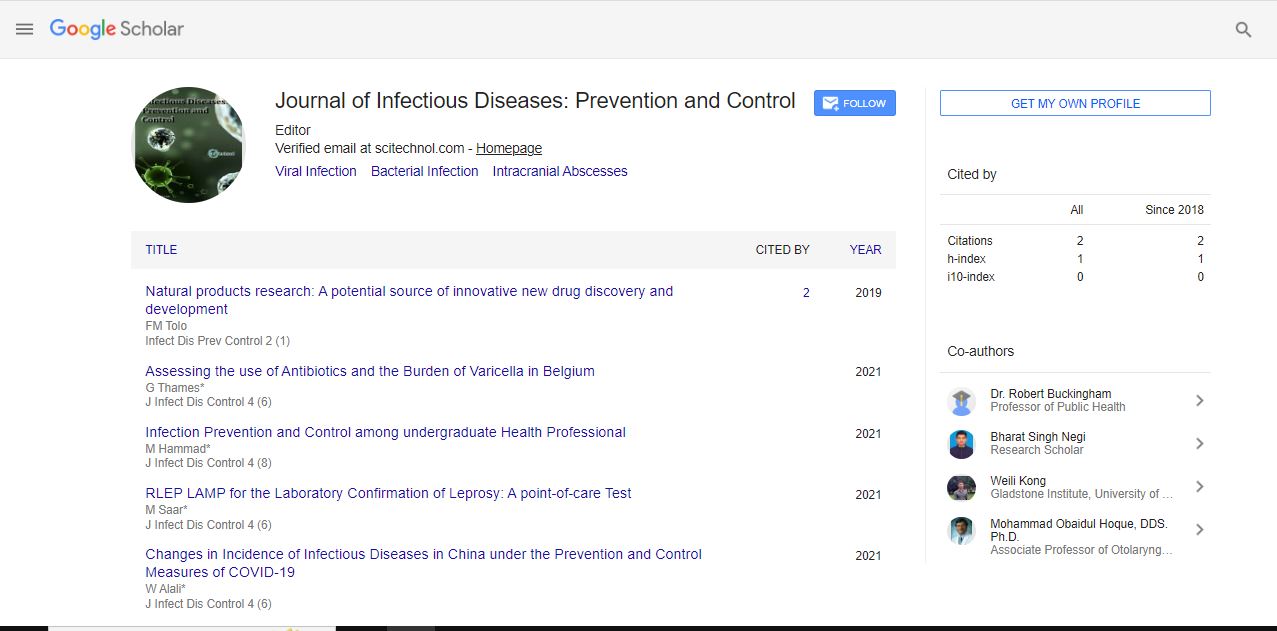Opinion Article, Vol: 6 Issue: 1
Primary and Secondary Infections Based on Occurrence in the Body
Forough Farrokhyar*
Department of Surgery, McMaster University, Hamilton, Ontario, Canada
*Corresponding Author: Forough Farrokhyar
Department of Surgery, McMaster
University, Hamilton, Ontario, Canada
E-mail: foroughfarrokhyar@gmail.com
Received date: 21 February, 2023, Manuscript No. IDPC-23-95705;
Editor assigned date: 23 February, 2023, Pre QC No. IDPC-23-95705(PQ);
Reviewed date: 07 March, 2023, QC No. IDPC-23-95705;
Revised date: 14 March, 2023, Manuscript No. IDPC-23-95705(R);
Published date: 24 March, 2023, DOI: 10.36648/idpc.5.2.129
Citation: Farrokhyar F (2023) Primary and Secondary Infections Based on Occurrence in the Body . Infect Dis Prev Control 6:1.
Description
Infections can be categorized into primary and secondary infections based on their occurrence in the body. Both types of infections can be caused by a variety of pathogens such as bacteria, viruses, and fungi. Understanding the differences between primary and secondary infections can help individuals to better understand how infections occur, how to prevent them, and how to manage them effectively.
Primary Infections
A primary infection occurs when a pathogen enters the body for the first time and causes an infection. The immune system is not yet familiar with the pathogen, and so it needs time to mount an effective response. This means that primary infections can be more severe and take longer to resolve than secondary infections. Common examples of primary infections include chickenpox, measles, and the flu. Symptoms of primary infections can vary widely depending on the pathogen involved. Some common symptoms of primary infections include fever, fatigue, cough, sore throat, and body aches. In some cases, primary infections can cause more serious symptoms such as difficulty breathing, seizures, and organ failure.
Primary infections can be prevented through a variety of measures, including vaccination, good hygiene practices, and avoiding contact with infected individuals. Vaccination is particularly effective at preventing primary infections, as it helps the immune system to recognize and fight off pathogens before they can cause an infection.
Good hygiene practices such as hand-washing, covering the mouth and nose when coughing or sneezing, and avoiding close contact with sick individuals can also help to prevent the spread of primary infections. When primary infections do occur, they can be treated with a variety of medications such as antibiotics, antivirals, and antifungals depending on the type of pathogen involved. Supportive care such as rest, fluids, and over-the-counter medications can also help to manage symptoms and speed up recovery.
Secondary Infections
A secondary infection occurs when a pathogen that is already present in the body causes an infection. This can occur when the immune system is weakened or compromised, allowing the pathogen to multiply and spread. Secondary infections are often more severe than primary infections and can be more difficult to treat. Common examples of secondary infections include pneumonia, urinary tract infections, and wound infections. These infections can occur in individuals who have weakened immune systems due to conditions such as HIV/AIDS, cancer, or diabetes. They can also occur in individuals who are taking immunosuppressive medications such as corticosteroids or chemotherapy.
Symptoms of secondary infections can vary depending on the type of infection and the pathogen involved. Common symptoms include fever, chills, cough, difficulty breathing, and fatigue. In some cases, secondary infections can cause more serious symptoms such as sepsis, organ failure, and death.
Preventing secondary infections is often focused on addressing the underlying condition that is causing the immune system to be compromised. This can involve treating the underlying condition, adjusting medications, or making lifestyle changes such as improving diet and exercise habits. Good hygiene practices such as hand-washing and avoiding close contact with sick individuals can also help to prevent the spread of secondary infections. When secondary infections do occur, they can be more difficult to treat than primary infections due to the presence of underlying conditions that can complicate treatment. Antibiotics, antivirals, and antifungals may still be effective, but may need to be used for longer periods of time or in combination with other medications. Supportive care such as fluids, oxygen therapy, and hospitalization may also be necessary.
 Spanish
Spanish  Chinese
Chinese  Russian
Russian  German
German  French
French  Japanese
Japanese  Portuguese
Portuguese  Hindi
Hindi 